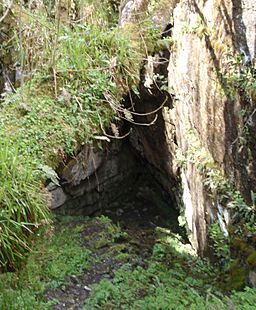Pollnagollum facts for kids
Quick facts for kids Pollnagollum–Poulelva |
|
|---|---|

Pollnagollum entrance pothole
|
|
| Location | The Burren, County Clare, Ireland |
| Depth | 140 m (460 ft) |
| Length | Approx. 16 km (9.9 mi) |
| Geology | Limestone |
| Entrances | 8 |
| List of entrances |
Pollnagollum Poulelva Pollbinn |
| Translation | Cave of the Pigeons |
| Pronunciation | [Powl-nah-gollum] |
| Associated caves | Bullock Pot |
Pollnagollum–Poulelva (often called Pollnagollum) is an exciting cave system in County Clare, Ireland. It's special because an active stream flows right through it!
Exploring Pollnagollum Cave
Pollnagollum is a very long cave. It stretches over 16 kilometres (9.9 mi), making it the longest cave on the island of Ireland. It is also the third deepest cave in the country. The cave is mostly made up of winding passages where the stream flows. These passages connect in many ways, offering different routes for explorers.
Most people enter through the Pollnagollum opening. You will find the main streamway a short distance inside. This main stream flows for most of the cave's length. Several smaller streams join it along the way. Near the southern end of the cave, you will find the 30-metre (98 ft) deep Poulelva pot. Cavers often use both the Pollnagollum and Poulelva entrances for through-trips.
Much of the water in the cave comes from "sinks" in Upper Pollnagollum. A sink is where surface water disappears into the ground. Here, water from the shale bedrock sinks into the permeable limestone. The cave ends in a low, flat passage that eventually becomes too tight to go further. The water then comes back to the surface at the Killaney rising, south of the cave.
Discovering the Cave's Secrets
The first known exploration of Pollnagollum cave was in 1880. T. J. Westropp ventured as far as the Main Junction. However, serious exploration did not begin until the 20th century.
E. A. Baker started the first systematic exploration of the cave in 1912. He returned in 1925 and created a partial survey of the cave. In 1935, the Yorkshire Ramblers' Club made the first descent into Poulelva. A major survey and article were published in 1944. This work was done by J. C. Coleman and N. J. Dunnington for the Royal Irish Academy.
In 1952, cavers from the RAF discovered Branch Passage Gallery. They connected it to the rest of the cave in 1953. The University of Bristol Spelaeological Society carried out a full survey in the 1960s. By then, 10 kilometres (6.2 mi) of the cave had been discovered. This society still keeps the survey updated as cavers continue to find new passages. Pollnagollum is one of the most popular caves for cavers in Ireland. It is often used for beginner trips.

